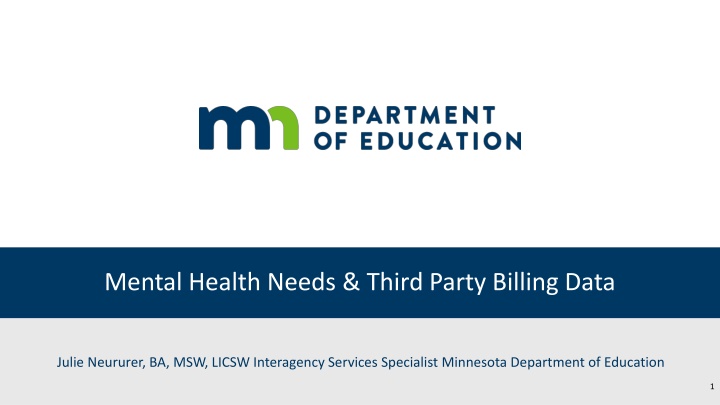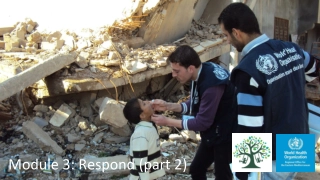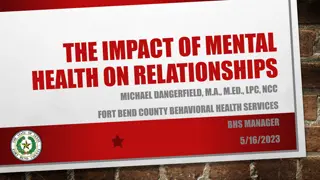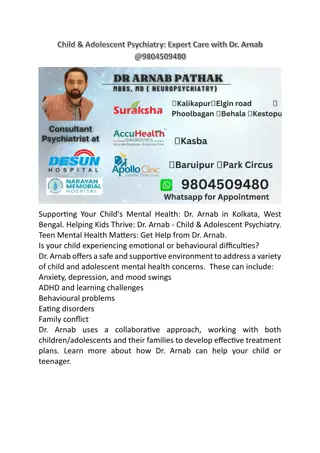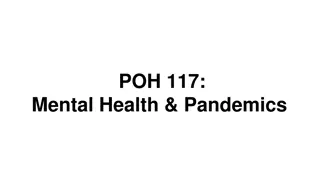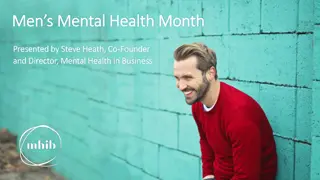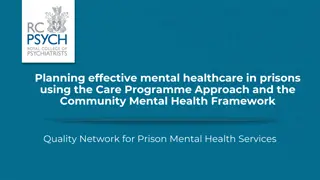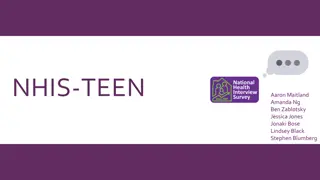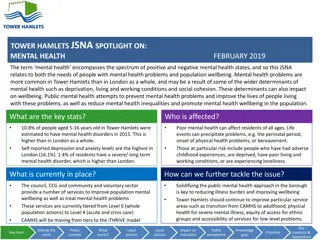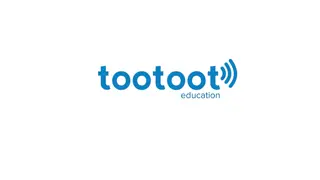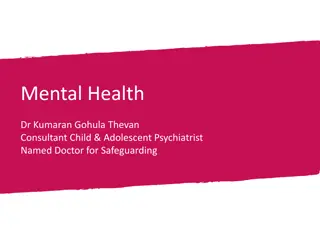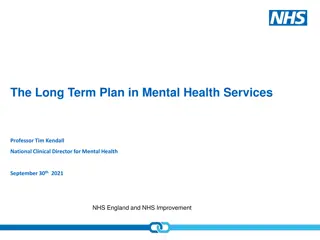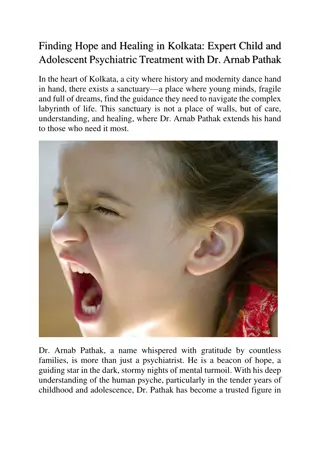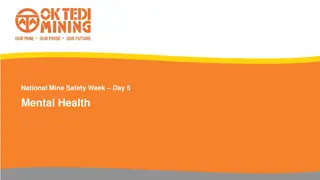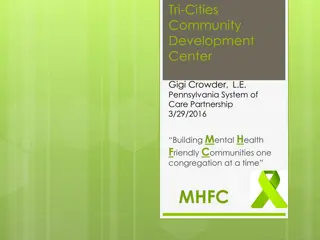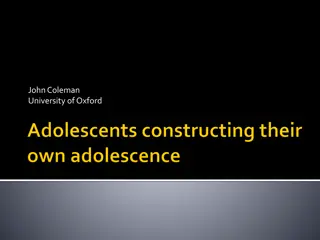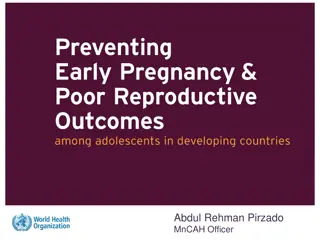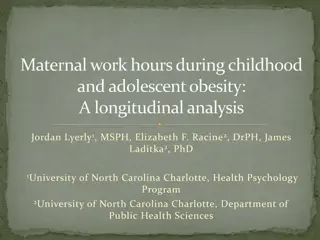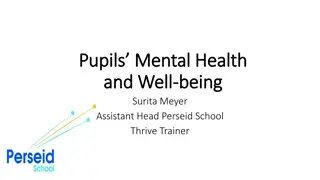Addressing Child and Adolescent Mental Health Needs
Public schools in Minnesota can request payment from health insurers for IEP health services, ensuring children receive necessary support. Reimbursable services include therapy and nursing, with funds reallocated for student benefits. Statistics reveal a significant mental health burden among youth, emphasizing the importance of proactive support within educational settings.
Download Presentation

Please find below an Image/Link to download the presentation.
The content on the website is provided AS IS for your information and personal use only. It may not be sold, licensed, or shared on other websites without obtaining consent from the author.If you encounter any issues during the download, it is possible that the publisher has removed the file from their server.
You are allowed to download the files provided on this website for personal or commercial use, subject to the condition that they are used lawfully. All files are the property of their respective owners.
The content on the website is provided AS IS for your information and personal use only. It may not be sold, licensed, or shared on other websites without obtaining consent from the author.
E N D
Presentation Transcript
Mental Health Needs & Third Party Billing Data Julie Neururer, BA, MSW, LICSW Interagency Services Specialist Minnesota Department of Education 1
What is Third Party Billing Federal and state law require all public Minnesota schools to request payment for Individualized Education Program (IEP) health-related services from public and private health insurers. Minnesota Health Care Programs (MHCP) pays the federal share of covered health-related services described on a child s IEP or Individualized Family Service Plan (IFSP). 3
What Is Third Party Billing Schools are reimbursed when a child has a disability and an IEP or IFSP, requires health-related services in order to benefit from special education, and is eligible for Minnesota Health Care Programs (MHCP). Reimbursable IEP health-related services include assessments and services for: Physical therapy.-Occupational therapy-Speech-language-hearing-Children s Therapeutic Services and Supports (Mental Health)-Nursing-Personal care assistance services-Assistive technology devices (medical equipment)-Special transportation-Oral and sign language interpreter services. 4
Use of Third Party Funds Reallocate reimbursements- for the benefit of students with Individualized Education Programs or Individualized Family Service Plans. 5
Prevalence of Child and Adolescent Mental Health Each year 1 in 5 children experience a mental health disorder An estimated 10% of children and adolescents in the U.S. have a Serious Emotional Disturbance (SED) Suicide is the 2nd leading cause of death among people age 10-34 1 in 4 children attending schools have been exposed to a traumatic event Only 13% of children from diverse racial and ethnic backgrounds receive mental health services Approximately 80% of children and adolescents with mental health diagnoses have unmet mental health needs. School principals report that student mental health needs are one of their biggest challenges According to the Student Survey: Mental health rates increased for all grades and genders 6
Student Survey-Mental Health Seriously considered suicide in the last 12 months Special Ed Students General Ed Students 2013 2016 2019 19.0% 19.0% 18.3% 18.1% 17.8% 17.0% 17.0% 17.2% 17.0% 16.4% 15.0% 15.0% 15.0% 14.4% 13.0% 13.0% 12.8% 12.5% 12.2% 12.1% 11.7% 11.0% 11.0% 11.5% 11.3% 11.2% 10.4% 9.0% 9.0% 9.3% 7.0% 7.0% 5.0% 5.0% Grade 8 Grade 9 Grade 11 Grade 8 Grade 9 Grade 11
Student Survey-Mental Health Who are students talking to about problems they are having? Adult at School 35% 24% 22% 20% Grade 5 Grade 8 Grade 9 Grade 11
Rationale for providing school student support staff services Allows schools to recognize mental health needs Fewer disciplinary encounters More school engagement Elevated rates of graduation Promote academic achievement and decrease in need for special education Schools provide increased access to care Decreased stigma when seeking treatment Schools use multidisciplinary approaches to help provide early identification, evidence based interventions, and a full continuum of services Cost effective 9
Rationale for Third Party School Social Work Reimbursement School social workers who are qualified mental health professionals and practitioner are currently providing Medicaid eligible behavioral health services but are not accessing those federal Medicaid dollars. Medicaid is the primary payer for IEP/IFSP health related services in the schools, not the LEA s; yet schools are drawing down their educational funds to provide these services adding to and increasing cross subsidy. Accessing federal Medicaid funds is a sustainable revenue source that helps maintain the staffing and build school capacity to provide theses medically necessary behavioral health services. Provides resources for school social workers to provide consistent and reliable access for students and their behavior health needs. Federal Medicaid funding helps increase health equity across schools by targeting reimbursement to schools billing for higher rates of Medicaid penetration. The Third Party Program supports the Community in the Schools & a Comprehensive School Mental Health system model. If Minnesota schools were able to access Federal Medicaid funding using the Special Education criteria, like all other health related services, schools would have more resources to support mental health providers in the school. 10
Current Options for School Mental Health Billing in Minnesota If your school wants to provide Children's Therapeutic Support Services (CTSS) services, you must follow the certification process for one of the two CTSS certification options list below. 1. Contract School CTSS School will contract with a certified CTSS community provider 2. School CTSS CTSS services are directly provided by mental health professionals and practitioners employed by the school, or a combination of both school employees and also contracted CTSS community providers 11
District CTSS Participation Mental Health Third Party Billing Of approximately 560 districts in the state: 9 districts in the state are currently School CTSS CTSS services are provided by school employed mental health professionals and practitioners, or a combination of both school employees and contracted community providers 35 districts are currently Contract School CTSS Schools contract with a certified CTSS community provider only 12
Additional CTSS requirements Special Ed requirements to qualify and provide services to students with disabilities which includes mental health needs Additional CTSS billing requirements to bill Medicaid for students with an IEP mental health need Pre-referral interventions CTSS Certification and re-certification Comprehensive Evaluation Diagnostic Assessments (DA) Develop an IEP/IFSP Develop an Individual Treatment Plan (ITP) Progress reports Progress notes Case notes/clinical notes/progress notes Review the ITP every 90 days Administering and reporting standardized measures MH professionals/practitioners and licensed by PELSB 13
Survey Results: Top Barriers to Billing School Social Work Services Top barriers to billing School Social Work Services Other responses to barriers: CTSS is too difficult to understand Revenue does not cover the cost to bill District outside agency/school-linked mental health clinics Staff turnover I am unsure why our district does not bill Services no longer on IEP I didn t know we could bill for Social Work services Community resistance Schools should not be doing DA s Outside agency takes away all billing options from school employed LICSW DHS seems to change what they want from year to year #5 Lack of support, 16% #1 CTSS paperwork, 28% #4 Low reimbursement rates, 16% #2 Lack of qualified staff, 20% #3 Lack of training, 20% 14
Survey Results The #1 barriers to billing for school social work services is the burden of the duplicative paperwork required of CTSS and the Special Education due process Schools responded, if allowed to bill for school social work services without the constraints of CTSS, but instead under school special education eligibility criteria, just like all other health related services, schools would have more billing opportunities Better support and training was a constant consideration in maximizing nursing and school social work Medicaid reimbursement. The sharing of successful school processes and high quality examples for dissemination was also a theme 15
Primary Disabilities with Largest Enrollment Growth, FY 2013-FY 2019 Public School and Nonpublic Shared Time Students, Birth-21 3/1/2025 16
Third Party Billing Data Special Education Child Count Emotional Behavioral Disorder Child Count Students receiving school-based mental health services that were reimbursed with Medicaid through CTSS (option 2&3) Year 2015-2016 133,678 14,928 1,469 2016-2017 137,601 15,448 1,202 2017-2018 142,270 15,983 1,015 2018-2019 147,605 16,814 734 17
CTSS Third Party Billing Data Year Number of Minnesota school districts Number of Minnesota school districts receiving CTSS reimbursements for school based mental health services 60 Total Medicaid revenue to school districts for school based mental health services 2015-2016 555 $1,860,700 2016-2017 558 52 $1,647,201 2017-2018 564 48 $1,270,873 2018-2019 554 35 $1,299,617 18
School District Revenue from MHCP Reimbursement $56,000,000 District Revenue $53,000,000 $52,562,8 $50,132,622 $41,500,7 2014-15 2015-16 2016-17 2017-18 2018-19 School Year 19
Summary Research and data shows a continued need for mental Health services with significant impact on those students with unmet needs. The data also shows a lack of participation in the CTSS program. Survey results indicate the burden of additional paper work over and above what is already required for special education is the reason for nonparticipation. Medicaid is the primary payer for IEP health related services in the schools, not the LEA s; however schools are drawing down their educational funds to provide these services adding to the increasing cross subsidy. School social workers provide consistent and reliable access for students and their physical and behavior health needs but are not leveraging Medicaid funds. 21
Options Accessing revenue source may help a school district: Increase health equity across schools by targeting use of reimbursements Provide comprehensive school-based health care services. Maximize capacity to provide behavioral health services that support student attendance, engagement and achievement (ESSA). braiding 3rd party revenue with other district funds to help build comprehensive school physical and mental health services. Offer sustainable funding sources to provide school-based services for Medicaid-eligible beneficiaries. 22
Resources https://www.ecs.org/student-mental-health/ https://www.ecs.org/student-mental-health/ http://www.msswa.org/Childrens-Mental-Health-Facts https://www.medicaid.gov/federal-policy-guidance/downloads/CIB20190701.pdf https://www.ecs.org/student-mental-health/ http://www.msswa.org/Childrens-Mental-Health-Facts http://www.msswa.org/Childrens-Mental-Health-Facts https://www.medicaid.gov/federal-policy-guidance/downloads/CIB20190701.pdf https://www.jaacap.org/article/S0890-8567(17)31926-3/fulltex https://www.medicaid.gov/federal-policy-guidance/downloads/CIB20190701.pdf https://mn.gov/dhs/partners-and-providers/policies-procedures/childrens-mental-health/ctss/ 23
Thank you! Julie Neururer, BA, MSW, LICSW Interagency Services Specialist Minnesota Department of Education Julie.neururer@state.mn.us 11/26/2019 24
